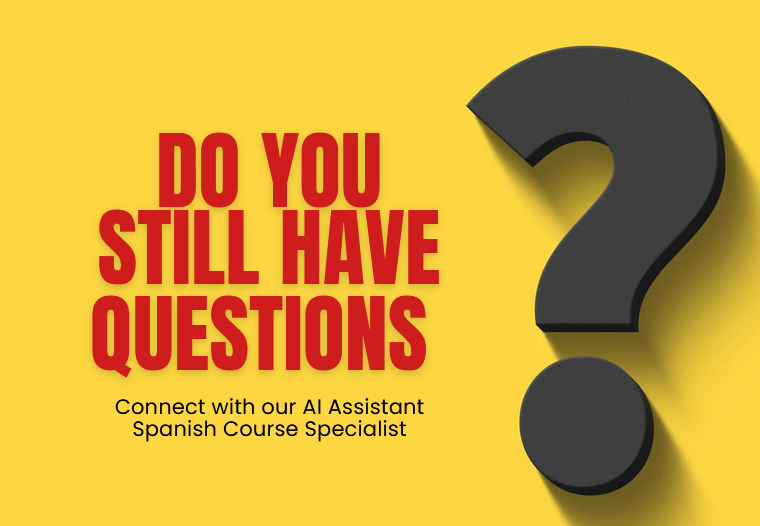Speak Spanish
Learning Spanish Does Not Have To Be Difficult
This method is focused on getting you speaking fast

Grab This Free Download Now
Conversational fluency is not as difficult as it seems. Discover common problem areas holding people back and tips on ways to move forward and actually start speaking Spanish.
Click Here and Tell Us Where to Send Your PDFMANY PEOPLE USING THESE METHODS STILL CANNOT SPEAK SPANISH
3 Popular Methods That Don't Work
Spanish Classes in High School or College
You learn basic phrases, grammar, numbers, seasons, months, colors and more, but not how to speak fluently.
Spanish Language Apps
Many use language apps hoping to become fluent but they focus on phrases and words used in various different scenarios.
Online Spanish Courses
Using Spanish courses and watching video's online give good information but never give quite enough information to become fluent.
Many People Get Stuck at Some Point While Learning Spanish and Can't Seem to Move Forward
If you've been trying to learn Spanish with apps, online courses and in school and still cannot have a conversation in Spanish after months or years of trying, it's not your fault!
Those methods are focusing on the wrong things and are actually holding you back from becoming conversationally fluent. It is easier than you think. Watch the free training to get usable tips that will help you to finally move forward and reach fluency fast.

¡HOLA!
If you've been studying Spanish and don't feel like you're advancing as fast as you'd like, I can help you. I have been where you are, trying to have conversations with native speakers but struggling because I couldn't even make more than a simple sentence. I figured out what was missing and advanced to a high intermediate level in a few short months. You could drop me in the middle of Mexico or Venezuela and forbid me to speak English and it wouldn't be a problem. It is easier than you can imagine. I decided to design a course detailing what I did to achieve fluency to help others that may be struggling. Joe Standley
Compliments From Native Speakers While Putting This Method To Use
"How do you know so many words? You have a such large vocabulary!"
"Your Spanish is so good, you don't even have an accent!"
"Wow, you speak better Spanish than my teenage kids!"
"Ha ha, I didn't expect to see a tall American guy when I turned around."
"Have you lived in Mexico or are you married to a Mexican?"
"Where did you learn to speak Spanish so well?"
"You sound like you are from somewhere in Mexico or south America."
"You are so good, how do you know Spanish?"
Speak Spanish Course
The only method that really works

Conversational Fluency is Easier Than You Can Imagine
What is Conversational fluency?
It is a specific aspect of language proficiency that focuses on one's ability to engage in natural and meaningful conversations in a given language, such as Spanish.
It means being able to speak and understand the language well enough to comfortably communicate with others in everyday, real-life situations.
Basically it is the ability to say pretty much what you want to say, when you want to say it. Conversational fluency typically includes the following elements:
Listening - A person with conversational fluency can understand spoken Spanish from native speakers or proficient speakers. They can follow conversations, even when the topics may be unfamiliar or the speakers use common local expressions.
Speaking - Someone who is conversationally fluent can express themselves easily and effectively in spoken Spanish. They can initiate and maintain conversations, ask questions, provide explanations, and convey their thoughts and opinions without struggling to find words or phrases.
Pronunciation and Intonation - Conversational fluency often involves having a reasonably accurate pronunciation and intonation. While perfect pronunciation may not be necessary for fluency, a speaker should be easily understood and not have a strong foreign accent that hinders comprehension.
Vocabulary and Idioms - A conversationally fluent person has a broad vocabulary and an understanding of common native expressions and phrases used in everyday speech.
Grammar - While not necessarily perfect, conversational fluency includes a good grasp of grammar, allowing the speaker to construct sentences and convey meaning effectively. Small grammatical errors may be present, but they do not significantly impede communication.
Understanding - Conversational fluency involves the ability to understand and respond appropriately to various social situations and in conversations, such as humor, politeness, and context-specific language use.
Conversational fluency is often the goal for many language learners because it allows them to engage in social interactions, make friends, travel comfortably, and conduct business or work-related conversations in the target language. It will also give you a big enough base knowledge to be able to read and write in Spanish. Achieving conversational fluency can vary in terms of the time and effort required, depending on factors like the learner's prior language experience, the intensity of language study, and the complexity of the language being learned. It's an essential milestone on the path to overall language proficiency and for most people it is the end goal.
CHOOSE A METHOD THAT ACTUALLY WORKS
If You Are Ready to Get Conversationally Fluent in Spanish, Click The Button Below to Purchase The Solution to Your Problems & Start to Actually Have Conversations in Spanish Instead of Wishing For it
If you want good actionable tips to help you reach conversational fluency fast, register for the free training below to learn about the things that are keeping you from fluency and how to redirect focus to get results

